
- ARAB NEWS
- 05 Jul 2025

I recently had the pleasure of visiting AlUla, the magical ancient city in the northwest of Saudi Arabia. The excitement is in discovering the beauty of this small city, which is only an hour and 15 minutes’ flight from Jeddah. AlUla is a successful example of the Kingdom’s efforts in diversifying its economy by focusing on tourism.
AlUla is fast becoming a domestic and international tourist destination. Winter is the best time to visit, when the weather is nice during the day and a little cold in the evening. AlUla’s four-month season of entertainment has just kicked off. There is a lineup of events featuring Saudi, regional and international stars, who will ignite the desert night at the mirrored Maraya Hall, a magnificent structure with a rooftop restaurant offering a spectacular 360-degree view of sand dunes, mountains and sky.
To experience other enchanting nights under the desert sky there are several beautiful locations for fire camps, including in the shadow of the dramatic Elephant Rock, where soft music, Arabic coffee and traditional food can be savored in an atmosphere of tranquility and serenity.
However, it is the breathtaking and historically rich Hegra — the first UNESCO World Heritage Site in Saudi Arabia — that is truly mesmerizing, with its preserved tombs inside mountains, carved facades, sandstone outcrops in amazing shapes, and historic dwellings and monuments from the Nabataean Kingdom (1st century A.D.) that are still intact. As oases on the crossroads of famous ancient incense-trading routes running from southern Arabia to Egypt and beyond, the area is full of undiscovered old towns.
AlUla was the capital of the ancient kingdoms of Dadan and Lihyan, which controlled the caravan trade in the first millennium B.C. Walking through the labyrinth of narrow streets, inside the homes and archeological ruins, one can almost smell the incense and experience the bustle. There are traces of human history that stretch from 200,000 B.C. until the Islamic period, making exploring AlUla a fascinating journey through time.
Another must-visit place is the beautiful canyon of Sharaan Nature Reserve, where visitors can enjoy tracking wild animals, such as gazelle, ibex, ostrich and the Arabian leopard, gaze at the stunning mountain shapes and colors, and discover hidden treasures such as caves and script carvings. A resort is being established in the middle of this remarkable natural beauty.
The breathtaking and historically rich Hegra — the first UNESCO World Heritage Site in Saudi Arabia — is truly mesmerizing.
Maha Akeel
While I was in AlUla, I attended its annual dates festival. There was an amazing variety of dates, which AlUla is famous for, along with its citrus fruits. I was impressed by the young women entrepreneurs who created food items and skincare products from dates and the moringa peregrina plants, which have valuable nutrient and medicinal properties. AlUla has established a moringa center for quality control, research and development. This has the potential to be a unique local industry.
I also had the opportunity to visit the first public school for girls in Saudi Arabia, which was opened in AlUla in the 1960s, when girls were first officially enrolled in schools. The building was renovated last year to be a center for training artisans in various high-quality handicrafts in cooperation with UK foundation Turquoise Mountain. The initiative has already proven successful, as commissions to create special items for specific events have been made. AlUla is also in the process of opening a center for languages. It is these kinds of social development projects that will create a sustainable economy for the area.
There is also a thriving movie industry in AlUla, which has become a favored location for shooting films such as the upcoming Gerard Butler action thriller “Kandahar.” Next to me on the plane to AlUla was one of the producers of the film and he said he loved the region’s diverse and magnificent locations. He said it has great potential once local talent and equipment becomes abundantly available, which would reduce costs and make the logistics easier.
A little more attention is needed on offering tourist guides and tour companies that could provide packages and professional services, as well as flight options and a range of hotel room prices.
The Royal Commission of AlUla last week signed a five-year agreement with UNESCO for a strategic partnership to develop the cultural significance of the region, marking another step forward for Saudi Arabia’s sustainable development endeavors.
The best thing about promoting national tourism sites, in addition to developing the tourism industry with all its economic benefits, is discovering the ecological diversity, historical richness and captivating culture of the different regions in Saudi Arabia. Knowing and interacting with people and engaging with local cultures plays a big role in shaping opinions and impressions about a country. It is one of the long-lasting soft powers and is a tool of cultural diplomacy.
Saudi Arabia has long been a magnet for Muslims from around the world thanks to the holy cities of Makkah and Madinah, where it has generously developed and expanded the two holy mosques, has been a faithful custodian of them, and has mastered the service and care of pilgrims. Now, with this same dedication and experience, it is welcoming tourists from around the world to its vibrant large cities — especially the capital Riyadh, which is being transformed into a global city — and its smaller exotic and unique cities in valleys and on top of mountains. Meanwhile, exciting new cities such as NEOM and the Red Sea Project are rising on the cutting edge of technology and innovation.